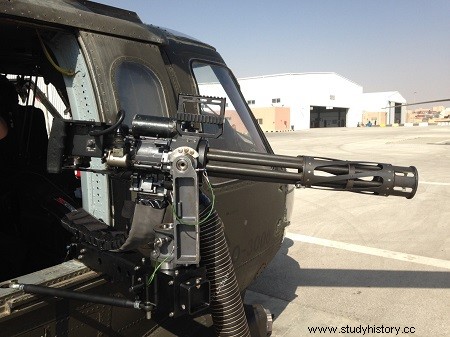
A minigun is a machine gun with a high rate of fire, equipped with several guns whose rotation is driven by an external source, on the principle of Gatling, and using a caliber of ammunition for rifle lower than 20 mm. Beyond 20 mm caliber, this type of weapon is referred to as a Gatling type automatic cannon.
History and operation
The principle of operation is that of the Gatling gun, it has the same advantages and disadvantages. A cylinder block protects the barrels and the power source is usually electric, hydraulic or pneumatic.
When, at the beginning of the 1960s, the United States entered the war in Vietnam, the helicopters engaged on the ground by the American army were equipped with machine guns, in order to counter the Vietcong infantry with short bursts at high rate. /P>
Engineers from the General Electric company therefore modified the 1959 M61 Vulcan in 1960, passing its caliber from 20 mm to a caliber of 7.62 x 51 mm NATO. The resulting weapon, known as the M134 Minigun, fires 1,500 rounds per minute. The minigun was quickly put into service on US helicopters and was installed on various attachment points (anchor points) available on these helicopters:the side pods of the Bell OH-6 Cayuse and the Bell OH-58 Kiowa , the turret and fins of the AH-1 Cobra, the doors, pylons and nacelles of the UH-1 Huey, and on many other helicopters and aircraft.
Several large aircraft were fitted with miniguns, particularly for close air fire support. These include the Douglas AC-47 Spooky, the Fairchild AC-119 Gunship or the AC-130 Specter Gunship.
